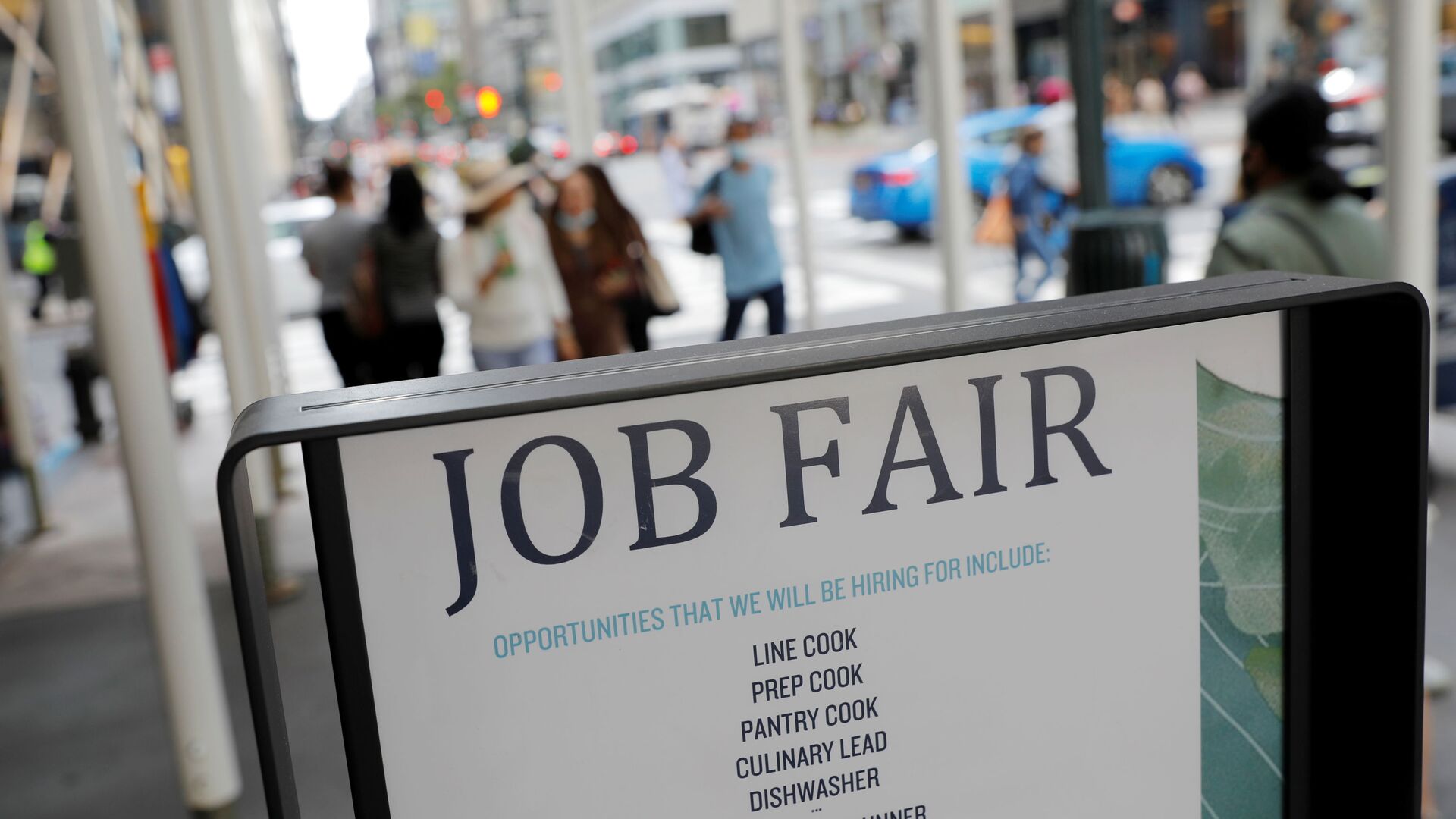https://sputnikglobe.com/20211208/us-jobs-quitting-rate-in-october-down-from-record-highs-labour-department-says-1091359188.html
US Jobs Quitting Rate in October Down From Record Highs, Labour Department Says
US Jobs Quitting Rate in October Down From Record Highs, Labour Department Says
Sputnik International
The number of Americans quitting their jobs fell from a record high in October while employment opportunities rose, diffusing the tight labour market situation in an expanding economy, the Labour Department said.
2021-12-08T17:03+0000
2021-12-08T17:03+0000
2022-08-06T13:27+0000
newsfeed
jobs
us
https://cdn1.img.sputnikglobe.com/img/07e5/09/03/1083792841_0:320:3072:2048_1920x0_80_0_0_f91755c95be0556c8ca165e294866b29.jpg
“The number of job openings increased to 11 million on the last business day of October,” the Labour Department said in its monthly Job Openings and Labor Turnover Summary (JOLTS).Hires in October were little changed at 6.5 million and total separations edged down to 5.9 million, the JOLTS report for the month said.“Within separations, the quits rate decreased to 2.8 percent following a series high in September,” the report added.The JOLTS report is a key indicator of labour market tightness or slack, and is closely watched by the Federal Reserve as criteria for raising and dropping interest rates.After staggering unemployment initially triggered by the measures to address COVID-19, the US labour market has steadily picked up this year, showing a jobless rate of just 4.2% in November from a high of 14.8% in April 2020.Analysts estimate that between 3 million and 5 million of the nearly 20 million jobs lost during the pandemic have not returned. Economists generally see the exodus as a greater opportunity in a pandemic-era market where workers could demand higher wages and prioritize child-care and health concerns.November’s jobless rate of 4.2%, interestingly, comes just above the 4% mark that the Federal Reserve defines as maximum employment in the United States.The US central bank needs maximum employment, inflation at 2% or more per annum and steady economic growth to hike interest rates, which it has kept at between zero and 0.25% since the onset of the pandemic nearly two years ago.The economy shrank by 3.5% for all of 2020 due to COVID-19 measures. Growth this year has been spotty, with an annualized 3.5% expansion in the first quarter, 3.6% in the second and 2% in the third.The Federal Reserve announced in March that it expected a 6.5% economic expansion for all of 2021 and has not changed its target despite the uneven growth in the past three quarters. The problem for the central bank though is inflation running at more than 30-year highs as prices of almost everything have soared from the lows of the pandemic due to higher wage demands and supply chain disruptions.
Sputnik International
feedback@sputniknews.com
+74956456601
MIA „Rossiya Segodnya“
2021
Sputnik International
feedback@sputniknews.com
+74956456601
MIA „Rossiya Segodnya“
News
en_EN
Sputnik International
feedback@sputniknews.com
+74956456601
MIA „Rossiya Segodnya“
Sputnik International
feedback@sputniknews.com
+74956456601
MIA „Rossiya Segodnya“
us jobs
US Jobs Quitting Rate in October Down From Record Highs, Labour Department Says
17:03 GMT 08.12.2021 (Updated: 13:27 GMT 06.08.2022) WASHINGTON (Sputnik) - The number of Americans quitting their jobs fell from a record high in October while employment opportunities rose, diffusing the tight labour market situation in an expanding economy, the Labour Department said on Wednesday.
“The number of job openings increased to 11 million on the last business day of October,” the Labour Department said in its monthly Job Openings and Labor Turnover Summary (JOLTS).
Hires in October were little changed at 6.5 million and total separations edged down to 5.9 million, the JOLTS report for the month said.
“Within separations, the quits rate decreased to 2.8 percent following a series high in September,” the report added.
The JOLTS report is a key indicator of labour market tightness or slack, and is closely watched by the Federal Reserve as criteria for raising and dropping interest rates.
After staggering unemployment initially triggered by the measures to address COVID-19, the US labour market has steadily picked up this year, showing a jobless rate of just 4.2% in November from a high of 14.8% in April 2020.
Analysts estimate that between 3 million and 5 million of the nearly 20 million jobs lost during the pandemic have not returned. Economists generally see the exodus as a greater opportunity in a pandemic-era market where workers could demand higher wages and prioritize child-care and health concerns.
November’s jobless rate of 4.2%, interestingly, comes just above the 4% mark that the Federal Reserve defines as maximum employment in the United States.
The US central bank needs maximum employment, inflation at 2% or more per annum and steady economic growth to hike interest rates, which it has kept at between zero and 0.25% since the onset of the pandemic nearly two years ago.
The economy shrank by 3.5% for all of 2020 due to COVID-19 measures. Growth this year has been spotty, with an annualized 3.5% expansion in the first quarter, 3.6% in the second and 2% in the third.
The Federal Reserve announced in March that it expected a 6.5% economic expansion for all of 2021 and has not changed its target despite the uneven growth in the past three quarters. The problem for the central bank though is inflation running at more than 30-year highs as prices of almost everything have soared from the lows of the pandemic due to higher wage demands and supply chain disruptions.

